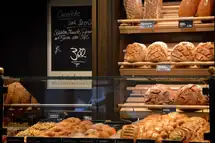What is a restaurant business ?
A restaurant is a business that prepares, serves, and sells food and beverages to customers in exchange for money. A restaurant business can be operated as a sole proprietorship, a partnership, a corporation, or some other legal form of business organization. Operating a restaurant business requires that the business owner have good food management skills and the ability to work with others. Here are some of the key points of running a restaurant business-
How To Open A Restaurant Business Tips to Get You Started at Once
Study The Local Restaurant Industry
You wake up one fine morning and decide there is nothing more fulfilling than your own restaurant business. You feel you have had enough of your nine-to-five job, and don't want to run the rat race any longer. You cobble together rudimentary infrastructure and some capital, get hold of a cook, and start a restaurant overnight. Are you likely to succeed? There's a good chance you won't.
Setting up a food business takes months, if not years, of research and homework. A restaurant started in a hurry, without careful strategizing may not bring home the bacon!
A study of the local restaurant industry needs to be undertaken. This will reveal the best practices followed by restaurants that have already been operating in the area, and help identify the requirements specific to that area or customer base. New businesses can build pricing structures after carefully considering how similar items are priced in the locality. It will also allow aspiring food entrepreneurs to learn from the mistakes committed by established businesses.
A look at the local food industry, for example, may point toward technology being adopted more and more, especially in the wake of the Covid-19 pandemic, even by sit-down restaurants that had been traditionally reluctant to use online innovations.
An aspiring entrepreneur may also discover that restaurants in the area have been offering customer-focused services like feedback forms, QR codes for placing tableside contactless orders and making payments, online ordering and home delivery of food, cashless modes of payment, and so on.
An entrepreneur looking to open a restaurant in a locality dotted with offices may realize that customers mostly look to catch a quick bite around the place. So, a food truck or a quick-service restaurant is better suited to deliver profits than a fine-dining restaurant.
An aspiring restaurateur will be able to take notes from businesses that had ignored customer service, food safety and neglected demand forecastingfailing to earn big bucks as a result.
Create Your Restaurant Business Plan
A comprehensive business plan is required when starting a restaurant, as it is with any new business. Business plans break down every facet of the new venture, from the concept to the finances. The plan helps entrepreneurs elaborate on the finer points of their business and summarize them for potential investors. A business plan is built to give creditors the confidence that the business will succeed and not default on loans.
A business plan comprises an executive summary and a more detailed company overview. Aspiring restaurateurs should describe their concepts and menus in detail. The business needs to be pitched well to potential investors, and should convince them of the route the entrepreneur intends to take to make it a success. Investors also need to know what they stand to gain from the deal. They may ask for share-holding, promotions, and so on, in return for their investment.
Break-even analysis and sales forecasting will provide a clear picture of the plans of the enterprise, and these plans can be presented in a crystal-clear form through visual aids like graphs and charts. Aspiring entrepreneurs must also lay down their staffing needs in keeping with sales forecast and sales targets.
Having studied the local industry in detail and discovering local trends, the next objective of a new business would be to find ways to trump the competition. It needs to consider what extra facilities it can provide to customers. For example, offering two meals at the cost of one on Valentine's Day. Moreover, marketing and advertising strategies have to be strong and properly laid out.
Opening a restaurant is a lot of work and requires a lot of investment.
It can be difficult to know where to start when you’re opening your own restaurant.
What's Your New Restaurant Going to Serve?

You need to invest a fair degree of thought in your restaurant concept. The type of restaurant you intend to operate, the food you wish to serve, and the style of service you want to employ should all be included in your plan.
You must decide whether you want to open a fast food restaurant, a food truck, or a full-service restaurant. Do you want to serve Chinese, Indian, Mexican, Italian, or a combination of various cuisines? Do you want to open a bakery or a coffee shop, instead of a full-blown restaurant? Do you want to operate a cloud kitchen or a brick and mortar store that also supports online ordering and home delivery?
No business can succeed without a clear idea of what it wants to be, and where it wants to reach, and each decision should be data-driven. For example, if you propose to open a restaurant in northern California, Colorado, or Minnesotaplaces that have some of the highest concentration of Tibetansyou may want to build your menu around tsampa, balep, momo, and chang.
The menu that you choose will determine the kind of equipment you require, the abilities your kitchen employees must possess, and the type of crowd you will attract. If you want to make pizza, you'll need proofers, dough mixers, and chefs who know how to work with pizza dough.
Consider your demographic as well. If you receive a good deal on a lease in a college locality, your menu should be geared toward students. However, if you insist on creating an expensive menu, you must select a place where higher price points can be supported by the median per capita income.
Choose The Right Location for Your Small Business
When picking a location for your new restaurant, select a site with good visibility and plenty of automobile and pedestrian activity. A restaurant located in a deserted bylane, where parking vehicles is an uphill task, may put customers off and the restaurant may not draw a lot of traffic, despite providing good food.
However, prime locations come at considerable cost, and a startup must weigh the pros and cons before choosing one. You wouldn't want to miss sales by being nondescript, but you wouldn't also want to bite off more than you can chew in terms of costs. In case your location lacks visibility and accessibility, ghost kitchens are a better concept. Ghost kitchens offer no dine-in facility and work in the digital realm. Irrespective of their location, ghost kitchen operators can make good money.
The location of a restaurant also has a bearing on its labor costs. Higher wages have to be paid to recruit good employees in places with high costs and standards of living.
You need to find a location where eateries similar to yours have been thriving. But avoid an area that has many restaurants matching yours in size and concept. When you are just starting out, leasing will give you greater legroom if you choose to make modifications and adjustments to your business.
Raise Money for Your Restaurant Business
Begin by calculating overall restaurant launch costs as well as daily operating costs. Prepare a budget and estimate the amount of money you would need to run your restaurant in the coming year.
See how much money you have on hand and compare it with the cost of your project. This will tell you how much funding you need to source from outside. Include the price of licenses, building upkeep, equipment, and employee wages in your budget. Here are some options for obtaining money-
Traditional commercial loan- This is obtained straight from a bank. With a conventional commercial loan, you can expect cheaper interest rates and more access to financing. However, you will need to provide collateral and have a good credit score.
Business line of credit- This involves a maximum credit limit much like a credit card. Though lending conditions are tighter and the amount that can be borrowed may not be as high as some other loan types, interest only accrues as you use the money.
Small business loan- You can acquire such a loan from the bank directly. Additionally, many banks work with the US Small Business Administration (SBA), and their guidelines are designed to safeguard both, lenders and small entrepreneurs. It is necessary to provide collateral, though, and approval may take some time.
External investment- To locate investors for your restaurant business, you may tap into your network or subscribe to a site like AngelList. Angel investors provide capital to promising startups in return for a share of the company, typically in the form of royalties or equity.
Crowdfunding- Websites like Kickstarter, Indiegogo, FoodStart, and GoFundMe are excellent resources for raising funds through crowdfunding. Crowdfunding is the process of obtaining money for an enterprise from several people who each donate a modest amount, usually over the internet.
Starting a restaurant is a tough business. It takes a lot of time, money, and effort to get off the ground.
But you want to open a restaurant because you have the right idea, the right location, and a good plan.
Focus on Your Core Competencies

You must first pick a section of the food industry you wish to enter before you begin planning. Consider what you are best at or most comfortable doing, and for which you have a good supply of resources. Food businesses have many similarities, but there are also significant differences.
While the information and abilities required for success are similar, your interests will determine whether you establish a bakery, a fine-dining restaurant, a coffee cart, or any other type of business. Once the business type has been selected, you must determine which market niche you want to fill.
For instance, if you are an early riser, a casual breakfast-and-lunch establishment, or a bakery can be your niche. If you are a night owl, fine-dining businesses, bar-and-grill eateries, and even pizzerias will appeal to you.
Choose a business that allows you to interact with your customers frequently if you are particularly outgoing. If you are not so, you may choose a bakery, or a ghost kitchen, where you can focus on operations, rather than dealing with people.
Build a Great Team for Your New Restaurant
List out the positions you need to fill in order to run your business. Consider the number of days in a week you will stay open, and what your business hours will be. You also need to consider the demand you are expecting. Careful consideration of all these points will inform you of the number of front and back office staff you will require.
You need to create a good work culture from the very beginning, because it is not only enough to recruit the best talent, it is equally important to retain them. Retaining your employees will help you cut costs on recruitment, onboarding and training new employees, and also prevent your trade secrets from leaking out to your rivals. Therefore, when addressing your employees' work-life balance, it's important to factor in employee perks, and incentives.
Your staffing needs will vary, depending on your new restaurant's specific needs. Some common restaurant positions are-
Managers- General manager, front-of-the-house manager, and kitchen manager.
Kitchen staff- Head cook, prep cooks, sous chefs, line cooks, and dishwashers.
Front-of-the-house employees- Hosts, servers, bussers, and food runners.
Bar employees- Bartenders, cocktail servers, and barbacks.
You may also need to recruit public relations experts, marketing specialists, and accountants, and may need to bring in temporary staff during periods of high footfall.
Make Sure You have the Right Software
Startups should select the right technology that will get them up and running without burning a hole in their pocket.
Restaurants looking to compete in today's world must invest in robust restaurant point of sale systems. POS systems do more than just accept payments and process gift cards. They also update stocks in real time and generate extensive, automated reports on a variety of business-related topics. These reports are accessible round the clock from any handheld device. They give business owners insights into which items are doing well and which aren't, as well as provide customer contacts, purchasing trends, and prices.
A high-quality restaurant pos system cuts down the number of operational tasks and ensures that the time and effort needed to manage a business are reduced. It can also serve as a time clock for employees. Restaurant POS systems can support online ordering and customer relationship management as well. They are, in effect, real workhorses. Plum POS is such an all-round restaurant management solution.
However, startups with a leaner budget may want to opt for individual software solutions, rather than an all-inclusive POS system. For example, they may want to begin with an employee scheduling software like Zip Schedules, to help them control their labor costs. This restaurant scheduling app helps operators allocate and rotate their employees according to their needs. Its self-service feature lets employees manage their schedules independently, while its auto-scheduling feature allows managers to automate schedule-making.
An operator may alternatively only want to invest in a business intelligence and data analytics solution like Zip Reporting, which consolidates and interprets its data in the form of easy-to-read charts and graphs. If however, supply chain and restaurant inventory management is its top priority, a restaurant may want a product like Zip Inventory that will make sure there's always enough stock on hand to serve customers and prevent over-purchasing and wastage.
An all-inclusive restaurant management solution like Plum Pos, as well as specialized software like Zip Inventory, Zip Reporting, Zip Scheduling and others, can be purchased from the online restaurant app store, Hubworks. This platform also offers integrating software that can help businesses link their different technologies.
Build your Brand

You need to build a strong brand to be able to compete with established businesses to attract customer attention and build customer loyalty. Your brand sets you apart from competitors, and it's often the determining factor for customers in a world of limitless choices.
In order to know where your restaurant stands among rival brands and to identify your unique selling proposition, your product, promotion, placement, and pricing need to be properly evaluated.
Your restaurant's positioning should be based on its location and concept. Many of your decisionsfrom interior design to cuisine and staffingwill be dictated by your restaurant's concept. Factors that shape your positioning also include neighborhood stereotypes, local rivals, and accessibility.
To establish a clear and distinctive brand, you must pay attention to the smallest details. This involves paying close attention to your restaurant's name, logo, decor, menus, uniforms, the restaurant's website, and other channels of marketing like social media.
You will need to spread the word about your new restaurant to attract guests. An efficient and effective advertising campaign will help build excitement around your brand. A restaurant startup has to have an easy-to-navigate website, and accounts on sites like Yelp, TripAdvisor, and Google My Business, which will make it easy for guests to find more information about your business. Buzz around the restaurant can also be created through a grand opening.
Most important of all, you must stay tuned to sources of relevant and up-to-the-minute news about the restaurant industry sources like Restaurantslife.
Restaurantslife Features news, long-read articles, recipes, restaurant rankings, and much more that can help food entrepreneurs turn successful in no time.
Starting a restaurant business is no easy task, but it’s not impossible.
You may be wondering how to get started on your own restaurant business without making any costly mistakes.




